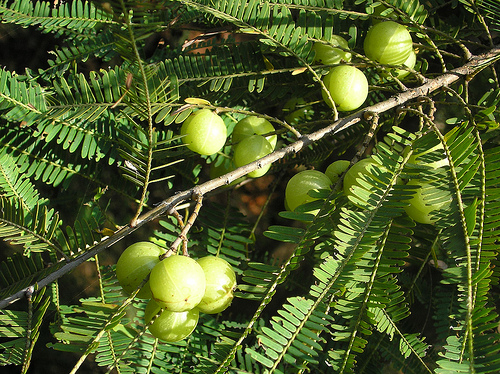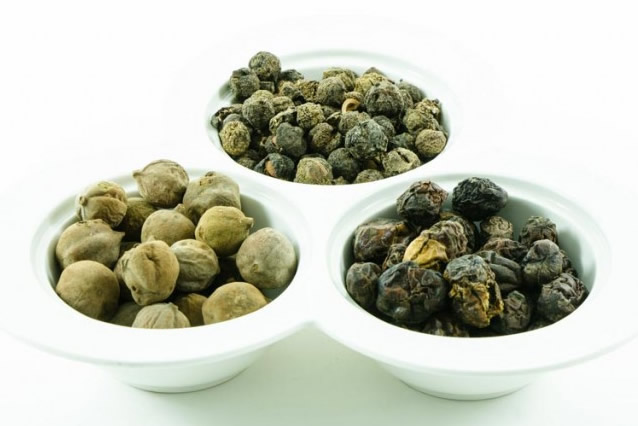 |
| Amalaki (Embelica officinalis) |
Triphala, an ancient herbal blend, is one of the most commonly used herbal remedies in the Ayurvedic system of healing. Ayurvedic medicine originated in ancient India, has developed over thousands of years, and is one of the oldest systems of healing.
Thus triphala is one of the longest-used herbal remedies in the world. Triphala, meaning “three fruits,” is made from the fruits of three trees that grow throughout India and the Middle East, including amalaki fruit (Embelica officinalis), bibhitaki fruit (Terminalia belerica), and haritaki fruit (Terminalia chebula).
In preparing triphala, these fruits are dried, ground into powder, and then blended together according to the precise directions of Ayrurvedic tradition. Amalaki fruit, also called amla or Indian gooseberry, is renowned as one of the best rejuvenating herbs in Ayurvedic medicine.
  |
It contains more vitamin C than almost any other fruit, consisting of nearly 3,000 mg of vitamin C per piece. It has been nicknamed the “nurse herb” in India, because of its widespread effectiveness against sickness and its cooling effects on the body.
Haritaki is also considered one of the most useful of Ayurvedic herbs, particularly for its rejuvenating, warming, and balancing effects. Combined with bibhitaki fruit, another tonifying and warming herb, these three compounds are believed to have healing and balancing effects on all three of the principal body types or constitutions (termed doshas) in Ayurvedic medicine. As a balanced formula, triphala can be effectively used by most people and is prescribed for a variety of health conditions.
General Use
 |
| amalaki, bibhitaki, and haritaki |
Triphala is taken as a general health tonic, useful for all body types and a variety of conditions. It is commonly prescribed to tone and strengthen the digestive system, particularly in cases of weak digestion and constipation. Triphala is a gentle laxative that can be used daily and is not habit-forming, and has no adverse effects on the intestinal flora (the microorganisms that aid digestion).
It is said to improve the function of the stomach and intestines, and is also prescribed for cases of excess stomach acid. Triphala regulates and detoxifies the bowels, improves overall health by increasing the efficiency and absorption of digestion, and reduces gas.
It has a balancing effect on the body’s metabolism, and is prescribed to restore appetite. The herbal compound also helps the body to eliminate excess fat, by improving metabolism. Because of its gentle properties, triphala is recommended as a digestive aid for the elderly and for those with sensitive stomachs.
In addition to restoring the balance of the digestive tract, triphala is used as a blood builder and purifier, and may increase red blood cell count and hemoglobin levels.
Some healers prescribe it for diabetes, for its balancing effect on blood sugar levels. It also has anti-cholesterol and anti-mucus properties in the body. Triphala is believed to strengthen the kidneys and liver, and is prescribed for hepatitis sufferers.
Triphala is a source of vitamin C and is believed to improve the function of the immune system. The herbs in triphala have anti-inflammatory properties. The remedy is prescribed for gout, a form of arthritis caused by excess uric acid in the body, and other inflammatory conditions. Triphala is said to have a calming and tonic effect on the nervous system, and is recommended for Alzheimer’s disease and other degenerative disorders of the nervous system.
Another use for triphala is to strengthen the eyes, particularly in cases of cataracts, glaucoma, and conjunctivitis. It can be used as an eyewash and may reduce soreness and redness in the eyes. Triphala can also be applied topically to the skin to speed the healing of bruises and sunburn.
Preparations
 |
| Triphala as powder |
Triphala is available as a powder, and in tablets and capsules as well. For those who do not like very strong and bitter tastes, tablets or capsules are recommended. Triphala can be taken daily. As a digestive tonic and laxative, it is best taken in the evening, about two hours after eating, and at least 30 minutes before bedtime.
No food should be eaten for one and a half hours after ingestion. Tablets and capsules can be swallowed, while the powder can be mixed thoroughly in a small amount of cold or warm water. The powder can also be simmered in water and drunk as a medicinal tea.
Individuals should start with small amounts of triphala, a quarter-teaspoon of the powder or one tablet, gradually increasing the dosage until finding the optimal dosage. No more than one teaspoon of the powder or four to six tablets or capsules should be taken per day. The dosage should be reduced in cases of stomach upset or diarrhea.
As triphala is not addictive, it can be taken over long periods of time. It is recommended that every ten weeks, users should stop taking the herbal compound for two to three weeks, to give the body a rest and to maintain the effectiveness of the remedy.
When used as an eyewash, one teaspoon of triphala powder can be added to one cup of boiled and cooled water. The solids should be removed by straining through a dense cloth. The eyewash can be applied to the eyes three times per day. For topical application to the skin, the powder can be mixed with a small amount of water to make an easily applied paste.
Precautions
Triphala is not recommended during pregnancy or nursing, and should not be used with cases of diarrhea and dysentery.
Side Effects
The use of triphala may increase intestinal gas at first, as a possible by-product of the cleansing and detoxification effects in the digestive tract. Loose stools or diarrhea may indicate too high a dosage, and the amount ingested should be reduced.
Interactions
There are no known interactions between triphala and standard Western prescription drugs as of 2004.
Iklan
 |
| Amalaki (Embelica officinalis) |
Triphala, an ancient herbal blend, is one of the most commonly used herbal remedies in the Ayurvedic system of healing. Ayurvedic medicine originated in ancient India, has developed over thousands of years, and is one of the oldest systems of healing.
Thus triphala is one of the longest-used herbal remedies in the world. Triphala, meaning “three fruits,” is made from the fruits of three trees that grow throughout India and the Middle East, including amalaki fruit (Embelica officinalis), bibhitaki fruit (Terminalia belerica), and haritaki fruit (Terminalia chebula).
In preparing triphala, these fruits are dried, ground into powder, and then blended together according to the precise directions of Ayrurvedic tradition. Amalaki fruit, also called amla or Indian gooseberry, is renowned as one of the best rejuvenating herbs in Ayurvedic medicine.
  |
It contains more vitamin C than almost any other fruit, consisting of nearly 3,000 mg of vitamin C per piece. It has been nicknamed the “nurse herb” in India, because of its widespread effectiveness against sickness and its cooling effects on the body.
Haritaki is also considered one of the most useful of Ayurvedic herbs, particularly for its rejuvenating, warming, and balancing effects. Combined with bibhitaki fruit, another tonifying and warming herb, these three compounds are believed to have healing and balancing effects on all three of the principal body types or constitutions (termed doshas) in Ayurvedic medicine. As a balanced formula, triphala can be effectively used by most people and is prescribed for a variety of health conditions.
General Use
 |
| amalaki, bibhitaki, and haritaki |
Triphala is taken as a general health tonic, useful for all body types and a variety of conditions. It is commonly prescribed to tone and strengthen the digestive system, particularly in cases of weak digestion and constipation. Triphala is a gentle laxative that can be used daily and is not habit-forming, and has no adverse effects on the intestinal flora (the microorganisms that aid digestion).
It is said to improve the function of the stomach and intestines, and is also prescribed for cases of excess stomach acid. Triphala regulates and detoxifies the bowels, improves overall health by increasing the efficiency and absorption of digestion, and reduces gas.
It has a balancing effect on the body’s metabolism, and is prescribed to restore appetite. The herbal compound also helps the body to eliminate excess fat, by improving metabolism. Because of its gentle properties, triphala is recommended as a digestive aid for the elderly and for those with sensitive stomachs.
In addition to restoring the balance of the digestive tract, triphala is used as a blood builder and purifier, and may increase red blood cell count and hemoglobin levels.
Some healers prescribe it for diabetes, for its balancing effect on blood sugar levels. It also has anti-cholesterol and anti-mucus properties in the body. Triphala is believed to strengthen the kidneys and liver, and is prescribed for hepatitis sufferers.
Triphala is a source of vitamin C and is believed to improve the function of the immune system. The herbs in triphala have anti-inflammatory properties. The remedy is prescribed for gout, a form of arthritis caused by excess uric acid in the body, and other inflammatory conditions. Triphala is said to have a calming and tonic effect on the nervous system, and is recommended for Alzheimer’s disease and other degenerative disorders of the nervous system.
Another use for triphala is to strengthen the eyes, particularly in cases of cataracts, glaucoma, and conjunctivitis. It can be used as an eyewash and may reduce soreness and redness in the eyes. Triphala can also be applied topically to the skin to speed the healing of bruises and sunburn.
Preparations
 |
| Triphala as powder |
Triphala is available as a powder, and in tablets and capsules as well. For those who do not like very strong and bitter tastes, tablets or capsules are recommended. Triphala can be taken daily. As a digestive tonic and laxative, it is best taken in the evening, about two hours after eating, and at least 30 minutes before bedtime.
No food should be eaten for one and a half hours after ingestion. Tablets and capsules can be swallowed, while the powder can be mixed thoroughly in a small amount of cold or warm water. The powder can also be simmered in water and drunk as a medicinal tea.
Individuals should start with small amounts of triphala, a quarter-teaspoon of the powder or one tablet, gradually increasing the dosage until finding the optimal dosage. No more than one teaspoon of the powder or four to six tablets or capsules should be taken per day. The dosage should be reduced in cases of stomach upset or diarrhea.
As triphala is not addictive, it can be taken over long periods of time. It is recommended that every ten weeks, users should stop taking the herbal compound for two to three weeks, to give the body a rest and to maintain the effectiveness of the remedy.
When used as an eyewash, one teaspoon of triphala powder can be added to one cup of boiled and cooled water. The solids should be removed by straining through a dense cloth. The eyewash can be applied to the eyes three times per day. For topical application to the skin, the powder can be mixed with a small amount of water to make an easily applied paste.
Precautions
Triphala is not recommended during pregnancy or nursing, and should not be used with cases of diarrhea and dysentery.
Side Effects
The use of triphala may increase intestinal gas at first, as a possible by-product of the cleansing and detoxification effects in the digestive tract. Loose stools or diarrhea may indicate too high a dosage, and the amount ingested should be reduced.
Interactions
There are no known interactions between triphala and standard Western prescription drugs as of 2004.
Post a Comment